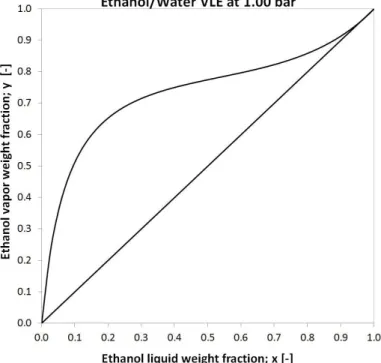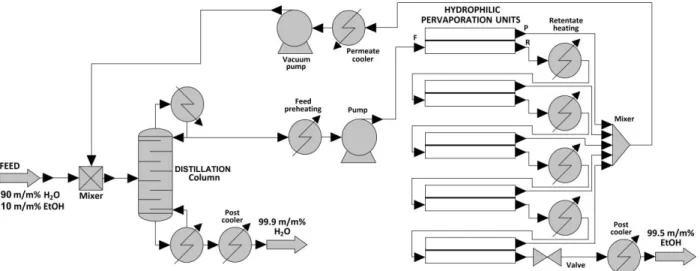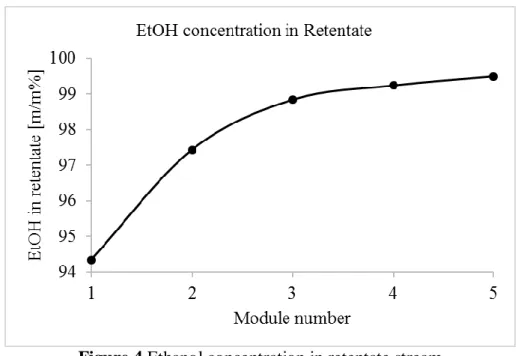Removal of ethanol from pharmaceutical process wastewater with distillation and hydrophilic pervaporation
A. J. Toth*
* Environmental and Process Engineering Research Group, Department of Chemical and Environmental Process Engineering, Budapest University of Technology and Economics, H-1111, Hungary, Budapest, Műegyetem rkp. 3. (E-mail: andras86@kkft.bme.hu)
Abstract
The work is motivated by an industrial problem, which is ethanol removal from pharmaceutical process wastewater. To complete this goal hybrid operation is investigated. Ethanol dehydration with combination of distillation and hydrophilic pervaporation is applied. The target of this work is to rigorously model and optimize this hybrid operation in professional flowsheet simulator environment. The number of minimal theoretical plates of distillation column and minimal effective membrane transfer area are determined. Considering the results, it can be concluded that, the distillation and hydrophilic pervaporation processes are suitable for separation ethanol and water in 99.5 weight percent purity and its cumulated heat duty is approx. 48% of extractive distillation.
Keywords
Process wastewater; Ethanol dehydration; Pervaporation; Flowsheet environment
INTRODUCTION
Water/alcohol separation is a well-known example of pervaporation (PV) process in chemical industry.
Ethanol (EtOH) forms minimal boiling homogeneous azeotropic mixture with water, which means separation problem. Alcohol content above 96 weight% can not be achieved with conventional distillation techniques (Marsden 1954), as it can be seen in Figure 1.
Figure 1 Vapour-liquid equilibrium of EtOH-Water mixture
Ethanol-water mixture can be separated with extractive distillation. The most commonly solvents are ethylene glycol (Meirelles et al. 1992; Ravagnani et al. 2010; Li & Bai 2012; Rojas et al. 2016) and glycerol (Gil et al. 2012), which can be used as entrainer. This technique has been widespread in the chemical and environmental industries, but it is not economical in many cases in the reason of its high operation cost. In contrast, the hybrid methods, where the distillation can be combined with other separation method, mainly with membrane processes can open new horizon for the alcohol separation (Koczka et al. 2007a; Koczka et al. 2007b; Koczka 2009; Koczka & Mizsey 2010; Toth 2015).
The separation process of the pervaporation is determined by the selective sorption, solution and diffusion in the membrane. This process is mainly used for dehydration of organics (Lipnizki et al.
1999a; Hsueh et al. 2005; Koczka et al. 2007a), removal of low concentration organics from its aqueous mixtures (Lipnizki et al. 1999b; Aroujalian et al. 2003; Konieczny et al. 2008) and organic-organic separation (Cunha et al. 2002; Smitha et al. 2004; Kuila & Ray 2012). Depending on the permeating component two main areas of pervaporation can be identified: hydrophilic and organophilic (hydrophobic) pervaporation (Nguyen & Nobe 1987; Zhang et al. 1992; Devaine et al.
1995). If the azeotropic composition can be approached with distillation, then the distillate product (D) can be further purified using hydrophilic PV.
The aim of this study is to separate of EtOH-water process wastewater (PWW) with combination of distillation and hydrophilic PV and to compare the heat duty with extractive distillation in professional flowsheet environment.
MATERIAL AND METHODS
In the pharmaceutical industry it is an actual problem that EtOH should be separated from an aqueous mixture (Toth & Mizsey 2015). PWW from pharmaceutical industry has to be separated with the following initial composition: 10 weight percent (m/m%) EtOH and 90 m/m% water. The product purity is 99.5 m/m% in both cases and 1000 kg/h PWW must be treated.
The ChemCAD flowsheet of extractive distillation can be seen in Figure 2.
Figure 2 Flowsheet of ethanol-water separation with extractive distillation
The first column is the extractive column, where the azeotropic mixture can be separated with ethylene glycol as entrainer. The second column treats the water-ethylene glycol mixture, the entrainer can be recycled and mixed into the feed stream. The optimal reflux ratio, the mass- and bottom flow rates, heating and cooling requirements, number of theoretical plates (N) and feed plate have to be optimized. As an equilibrium model for the calculation of the non-ideal vapour-liquid equilibria (VLE) the UNIQUAC model is applied.
ChemCAD professional flowsheet simulator is used for the investigation of hybrid separation (see Figure 3).
Figure 3 Flowsheet of ethanol-water separation with distillation and hydrophilic pervaporation First step, PWW is pumped into the middle of the distillation column and hydrophilic PV separates further the alcohol-rich intermediate product. It can be determined the suitable water can be received as bottom product (W) of distillation. Actually it is the purified PWW. The ethanol substance can be appropriate using this hybrid method as retentate (R) of hydrophilic PV.
Additional apparatuses are also needed for PV process (Toth et al. 2015). The temperature and the pressure must be increased for the operational level prior to the first membrane unit, because the feed (F) has atmospheric conditions, 20°C and 1 bar. Heat exchanger adjusts the temperate and pump increases the pressure prior to the first PV unit, too. Retentate stream is reheated after each membrane unit by further heat exchangers (Tusel & Brüschke 1985), except for the last module.
Permeate (P) streams leaving the PV units are collected, mixed, condensed with cooler and its pressure is increased again from vacuum with pump. This stream is mixed into feed stream of distillation column. The applied feed temperature in membrane modules is 70°C. Feed and permeate pressures are the following, 3 bar and 0.008 bar.
UNIQUAC thermodynamic model is applied in the case of SCDS distillation column and exponential Rautenbach model (Rautenbach et al. 1990; Valentínyi et al. 2013) for the hydrophilic PV. According to the methodology of Valentínyi et al. (2013) the pervaporation can be described with the following semi-empirical model:
(3)
Table 1 shows the estimated parameters of this semi empirical model.
Table 1 Estimated parameters for ethanol–water mixture with Sulzer PERVAP™ 4510 membrane (Valentínyi et al. 2013)
EtOH Water
B: Exponential parameter [-] 8.68 2.63
Ei: Activation energy [kJ/kmol] 128572 77877 Di: Transport coefficient [kmol/m2h] 1,93*10-5 2,02*10-4
RESULTS AND DISCUSSION
Table 2 shows the optimized results of extractive distillation separation.
Table 2 Optimized results of ethanol-water separation with extractive distillation method
Extractive column Recovery column
N [-] 20 15
Feed stage (PWW) 12 8
Feed stage (Ethylene glycol) 2 -
Reflux ratio [-] 2 1
D
EtOH [m/m%] 99.5 0.04
Water [m/m%] 0.4 99.9
Ethylene glycol [m/m%] 0.1 0.06
The results of simulations with distillation and hydrophilic PV process are listed in Table 3.
Table 3 Optimized results of ethanol-water separation with hybrid D+PV method
Distillation Pervaporation
F W D P R
EtOH [m/m%] 10 0.5 92 1 99.5
Water [m/m%] 90 99.5 8 99 0.5
Figure 4 depicts the EtOH concentrations of retentate stream in the function of membrane module numbers.
Figure 4 Ethanol concentration in retentate stream
It can be seen 5 membrane module is sufficient for reach the enrichment limit, which is 99.5 m/m%
ethanol.
The column has 15 theoretical plates and the reflux ratio is 2 in the optimized case. 80 m2 effective membrane transfer area is required for removal EtOH from PWW. It can be seen both method can
be removal ethanol from water. Table 4 summarises the cumulated heat duties.
Table 4 Heat duties of separation methods Calculated heat duties MJ/h Extractive distillation 1491 Distillation + Hydrophilic PV 710
It can be concluded that heat duty of extractive distillation is approx. twice of hybrid separation.
SUMMARY
The combination of distillation and hydrophilic pervaporation is investigated in professional flowsheet environment. It can be concluded ethanol-water mixture can be separated into pure components with this hybrid operation and with extractive distillation too. The target composition, which is 99.5 m/m% in both product case, can be reached and the heat duty of extractive distillation is significantly higher than hybrid method.
ACKNOWLEDGEMENT
The authors would like to acknowledge the financial support of János Bolyai Research Scholarship of the Hungarian Academy of Sciences and OTKA 112699 project.
REFERENCES
Aroujalian A., Belkacemi K., Davids S. J., Turcotte G. and Pouliot Y. (2003). Effect of protein on flux and selectivity in pervaporation of ethanol from a dilute solution. Separation Science and Technology 38(12-13), 3239-47.
Cunha V. S., Paredes M. L. L., Borges C. P., Habert A. C. and Nobrega R. (2002). Removal of aromatics from multicomponent organic mixtures by pervaporation using polyurethane membranes: Experimental and modeling. Journal of Membrane Science 206(1-2), 277-90.
Devaine K. M., Meier A. J. and Slater C. S. (1995). Pervaporation for the recovery of MEK and other solvents using organophilic membranes. In: Seventh InternationalConference on Pervaporation Process in the ChemicalIndustry Bakish R (ed.), Bakish Materials Corp., Reno, Nevada, p. 218.
Gil I. D., Gómez J. M. and Rodríguez G. (2012). Control of an extractive distillation process to dehydrate ethanol using glycerol as entrainer. Computers & Chemical Engineering 39, 129-42.
Hsueh C. L., Kuo J. F., Huang Y. H., Wang C. C. and Chen C. Y. (2005). Separation of ethanol- water solution by poly(acrylonitrile-co-acrylic acid) membranes. Separation and Purification Technology 41(1), 39-47.
Koczka K. (2009). Environmental conscious design and industrial application of separation processes. PhD Thesis, BME, Budapest.
Koczka K., Manczinger J., Mizsey P. and Fonyo Z. (2007a). Novel hybrid separation processes based on pervaporation for THF recovery. Chemical Engineering and Processing: Process Intensification 46(3), 239-46.
Koczka K. and Mizsey P. (2010). New area for distillation: Wastewater treatment. Periodica Polytechnica: Chemical Engineering 54(1), 41-5.
Koczka K., Mizsey P. and Fonyo Z. (2007b). Rigorous modelling and optimization of hybrid separation processes based on pervaporation. Central European Journal of Chemistry 5(4), 1124-47.
Konieczny K., Bodzek M. and Panek D. (2008). Removal of volatile compounds from the
wastewaters by use of pervaporation. Desalination 223(1–3), 344-8.
Kuila S. B. and Ray S. K. (2012). Sorption and permeation studies of tetrahydrofuran–water mixtures using full interpenetrating network membranes. Separation and Purification Technology 89(0), 39-50.
Li G. and Bai P. (2012). New Operation Strategy for Separation of Ethanol–Water by Extractive Distillation. Industrial & Engineering Chemistry Research 51(6), 2723-9.
Lipnizki F., Field R. W. and Ten P. K. (1999a). Pervaporation-based hybrid process: A review of process design, applications and economics. Journal of Membrane Science 153(2), 183-210.
Lipnizki F., Hausmanns S., Ten P. K., Field R. W. and Laufenberg G. (1999b). Organophilic pervaporation: Prospects and performance. Chemical Engineering Journal 73(2), 113-29.
Marsden C. (1954). Solvents And Allied Substances Manual With Solubility Chart. Cleaver-Hume and Elsevier, London.
Meirelles A., Weiss S. and Herfurth H. (1992). Ethanol dehydration by extractive distillation.
Journal of Chemical Technology & Biotechnology 53(2), 181-8.
Nguyen T. Q. and Nobe K. (1987). Extraction of organic contaminants in aqueous solutions by pervaporation. Journal of Membrane Science 30(1), 11-22.
Rautenbach R., Herion C. and Meyer-Blumentoth U. (1990). Pervaporation membrane separation processes. Membrane Science and Technology Series 1, 181-91.
Ravagnani M. A. S. S., Reis M. H. M., Filho R. M. and Wolf-Maciel M. R. (2010). Anhydrous ethanol production by extractive distillation: A solvent case study. Process Safety and Environmental Protection 88(1), 67-73.
Rojas J. V., Stinguel L., Wolf-Maciel M. R. and Guirardellom R. (2016). Modeling and Simulating Complete Extractive Distillation Process of Ethanol-Water Mixture Using Equilibrium-Stage Distillation Model and Efficiency Correlations (Barros & Wolf) on EMSO Platform. Chemical Engineering Transactions 50, 331-6.
Smitha B., Suhanya D., Sridhar S. and Ramakrishna M. (2004). Separation of organic–organic mixtures by pervaporation—a review. Journal of Membrane Science 241(1), 1-21.
Toth A. J. (2015). Liquid Waste Treatment with Physicochemical Tools for Environmental Protection. PhD Thesis, Budapest University of Technology and Economics, Budapest.
Toth A. J., Andre A., Haaz E. and Mizsey P. (2015). New horizon for the membrane separation:
Combination of organophilic and hydrophilic pervaporations. Separation and Purification Technology 156(2), 432–43.
Toth A. J. and Mizsey P. (2015). Methanol removal from aqueous mixture with organophilic pervaporation: Experiments and modelling. Chemical Engineering Research and Design 98, 123-35.
Tusel G. F. and Brüschke H. E. A. (1985). Use of pervaporation systems in the chemical industry.
Desalination 53(1-3), 327-38.
Valentínyi N., Cséfalvay E. and Mizsey P. (2013). Modelling of pervaporation: Parameter estimation and model development. Chemical Engineering Research and Design 91(1), 174-83.
Zhang S. Q., Fouda A. E. and Matsuura T. (1992). A study on pervaporation of aqueous benzyl alcohol solution by polydimethylsiloxane membrane. Journal of Membrane Science 70(2-3), 249-55.



